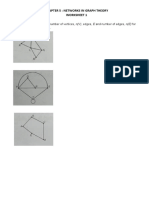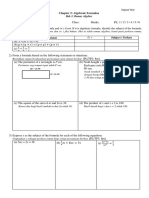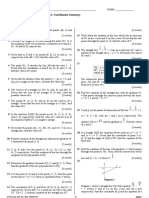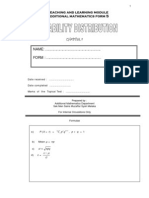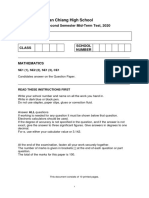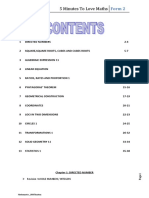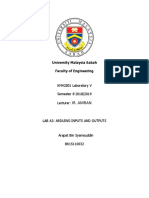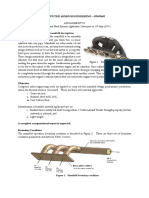0 ratings0% found this document useful (0 votes)
755 viewsMathematics Form 2 - Chapter 13 - Simple Probability
Uploaded by
Arapat SyamsuddinCopyright
© © All Rights Reserved
Available Formats
Download as PDF or read online on Scribd
0 ratings0% found this document useful (0 votes)
755 viewsMathematics Form 2 - Chapter 13 - Simple Probability
Uploaded by
Arapat SyamsuddinCopyright
© © All Rights Reserved
Available Formats
Download as PDF or read online on Scribd
You are on page 1/ 18
A pink team and a blue team are playing
against each other in a netball game, Based
‘on the records, the pink team scored 12 goals
‘out of 18 attempts. The blue team scored 18
13.1) Experimental Probability ‘goals out of 30 attempts. What is the ratio of =|
the goals to the attempts forthe pink teamand =
13.2 __ Probability Theory involving Equally blue team? In your opinion, which team will
Likely Outcomes win the game?
13.3 Probability of the Complement of an
Event
13.4 Simple Probability
WORD LINK
+ Probability + Kebarangkalian
+ Sample space + Ruang sampel
+ Event + Peristiva
* Complement of + Peristiwa pelengkap
anevent
* Theoretical probability + Kebarangkalian teori
* Experimental + Kebarangkalian
probability eksperimen
+ Tree diagram + Gambar rajah pokok
276
Richard Carl Jeffrey was an innovative
philosopher in the 20th century. He was also one
of the members in the department of philosophy
at Princeton University between 1974 10 1999,
He contributed much in the field of logic and
statistics. The book “The Logic of Decision’
written by him, discusses a new theory about
making decisions in a state of uncertainty and
the belief in possibilities. His writings are widely
used in the field of logic including ‘Formal
Logic: Its Space and Limits” and ‘Computability
‘and Logic’. He also wrote the book ‘Probability
and the Art of Judgement’ and ‘Subjective
Probability: The Real Thing’.
For more information:
WHY STUDY THIS CHAPTER?
Economists use the knowledge of probability
in predicting the increase or decrease in stock
value depending on the current economic
situation and political stability of a country.
Meteorologist use the science of probability
in predicting weather and wind change for
the days ahead.
Businessmen also use knowledge of
probability to review their business profit
statistics and to forecast the future profits
and earnings.
2r7
Crace
Chapter 13 Simple Probability
ity of each of the above situations and appropriate value to represent
‘The situations above indicate that the events may occur, will occur and may not occur. The possibility
of an event occurring is determined by the value between 0 to 1 and is known as probability.
13.1 Experimental Probability
In the Creative Activity, you are introduced to the probability concept. Now let’s look at the
relationship between frequency and the number of trials.
13.1.1 imental probabilit TNs
ae E STANDARD.
Exc ur s Teeth
8
frequency of appearance
Ratio
he frequency, ‘aumber oF fips
of appearance
head
100
Chapter 13 Simple Probabilty
Experimental probability is the probability that is obtained from an experiment. Ratio “frequency
of appearance towards number of flips’ that is obtained from flipping the coin is the experimental
probability for an event.
In general,
TN tear
BNP)
13.1.2 Experimental probability of an event
Cre
The file shows possible outcomes of obtaining head from flipping a coin. As much as 1 200 trials
of flipping the coin has been done. From the graph that is shown, the experimental probability of
‘obtained heads from 1 200 trials moves towards one value, that is 0.5.
Ttis observed that all the five graphs show the same shape. The conclusion that can be made is,
experimental probability moves towards a certain value if the experiment is repeated with a higher
‘number of trials.
a tmaeee 13.1
1, Perform an experiment by throwing a fair dice. Write the ratio of the number of obtaining even
‘numbers in 16 trials.
HAPTER 13
Cr
orn)
cs
Chapter 13 Simple Probabiity
13.2 The Probability Theory Involving Equally
Likely Outcomes
13.2.1 Sample space for an experiment
Before starting a football game, the referee usually flips the coin to
decide the team that will start the game. Why does the referee use a
coin and not dice or other objects? What is the sample space of the
possible outcomes of flipping a coin?
seth,
eo
‘Number on
the fair dice
When a fair dice is thrown, the number that is shown is either 1, DO YOU KNOW
2, 3, 4, 5, 6. Although the number shown is repeated, itis still [YE ment isa
in the range of 1 to 6. The outcome list for the thrown fair dice | "Procedure to observe
consists of numbers 1,2,3,4,5,6. The sample space for the thrown possible outcome.
fair dice is $= (1,2,3,4,5,6). _ Bie outcome i the
| possible result of an
|, periment.
3, Sample space is all the
possible outcomes of
oroup
Aim: Using a tree diagram to denote outcomes.
Materials: Two empty boxes labelled A and B, 4 pieces of card labelled 2, 3, 5 and 7
Steps:
1. Forma group of 5.
2. Place the card labelled 2 into box A.
Place the card labelled 3, 5, 7 into box B.
3.
5
Write the pair of numbers in the table below.
4. One student takes one card from box A and one card from box B.
5.
Member 1
Member 2
Member 3
Member 4
‘Member 5
Box A
Box B
5. Place both the cards into the original boxes.
Repeat steps 4 to 6 until all the members have a pait of numbers. Write the results in the
table,
List the outcomes using in the notation set, {_}
Discussion:
‘The similarities and differences of the paired number that is obtained by each member.
A tree diagram can help you determine probability.
When you pick a card randomly, you might get pairs like the ones
Box A
(2,3)
@,5)
27)
pir number obtained
‘Atree diagram can be
sed to show the flow of
a process. Itis used fo
‘organise and calculate
the probabiity of an
‘event happening.
shown in the tree diagram above. The possible outcomes of the
activity is known as sample space,
= (2,3), (2,5), (27).
‘Sample space is a set of all possible outcomes of an experiment.
281
Tatar
Crary
> Event of an experiment
reve
‘Aim: Identifying event
Materials: Two red balls, two yellow balls and a box
Steps:
1, Form groups of 4.
2. Mark every ball with the symbols M, and M, for the red balls. K, and K, for the yellow
balls.
. Place all the balls into the box.
}. One member takes two balls from the box, one by one.
Write the label of the ball that is taken in the table below,
. Place both the balls back into the box.
. Repeat steps 4 to 6 for each member. Complete the table below.
Member 1 | Member 2 | Member 3 | Member 4
ravae
First ball
‘Second ball
Outcome
Discussion:
‘The possible outcomes list that fulfils the following conditions.
(@ Two balls are of the same colour,
(ii) At least one ball is red.
The discussion in the activity above requires you to list the possible outcomes that fulfils two
conditions. The first condition is that both the balls are of the same colour. The second condition is,
at least one of the balls is red. The outcomes list that fulfils the conditions is known as event.
Eventis a set of possible outcomes that fulfils certain conditions array
for a sample space and is a subset for the sample space,
Set A= (1,3,5,7.9}
Set 8=@,4,6,8)
‘One letter is randomly chosen from the word SEMPURNA. List the | Sots m{@)=®
Set 8, r(8) = 4
possible outcomes and write the sample space for the experiment,
State the number of elements in the sample space.
Solution:
‘The word SEMPURNA is made up of eight different letters. The possible outcomes are S, E, M,
P,U,R,N, A. Sample space, S= (S, E, M, P, U, R, N, A). The number of elements in the sample
space, n(S) = 8.
282
Chapter 13 Simple Probabiity
A number is chosen randomly from the prime numbers between 20 to 40. List the possible
‘outcomes and write the elements in the sample space for this experiment. State the number of
elements in the sample space.
Solution:
Prime numbers are between 20 to 40 are 23, 29, 31, 37.
‘Sample space, § = {23, 29, 31, 37]. Number of elements in sample space, n(S) = 4.
‘A school cooperative sells brand P pencil. The erasers that are sold are red, green, blue and yellow.
alin wants to buy a pencil and one eraser. With the help of the tree diagram, list the possible
‘outcomes and write the elements in the sample space of the items bought by Palin. State the number
of pairs
Solution:
Step 1: Draw the tree diagram.
Re (PR)
(P.G)
(P, B)
(P.¥)
‘Outcomes
Step 2: List of elements in the sample space, S = {(P,R), (P,G), (P,B),(P.Y)}.
‘Therefore, number of elements in sample space, n(S) = 4
‘One card has been chosen from the box containing cards with numbers I to 9. Determine whether
the event below may occur.
(Number bigger than 5. (ii) Two digits number.
(iii) Factor of 15.
Solution:
Sample space , $= {1,2,3,4,5,6,7,8,9)
(May occur ii) May not occur
(iii) May occur
4 Caney
Caer
Chapter 13 Simple Probabiity
Ina telematch, the contestants must take one card that has the letters K, A, S, U, T from a jar. List the
clements in the sample space for the event, if
(@) consonant are chosen (b) vowel are chosen
Solution:
‘Sample space, K, A, S, U, T}
(a) Consonants = (K, S, T) (b) Vowels = (4, U}
Jar A has a card labelled J. Jar B has four cards labelled J, K, A and N. One card from Jar A and
one card from Jar B are picked.
(@) List the the elements in the sample space
(b) List the elements in the sample space if
(@. the letters are the same.
ii) at least one consonant is picked.
Solution:
Step 1: Draw the tree diagram
I aD
tt K| @®
z [4] Ga
N) @™
Jar JarB Outcomes
Step 2: Write the answers.
(a) S={(@,D, 0, ), 0,4),
(©) @ Event X= ((,D} (i) Event Y= ((1, K), .N))
13.2.2 Probability of an event
SET Py
‘Throwing a fair dice has six possible outcomes.They are numbers 1,
2,3, 4, 5 and 6. Assuming that each number has an equal chance of Oust Propaniy
appearing in a throw. What is the Eee
( chances of getting number 4. between theoretical
E : probability and
i) chances of getting an odd number. ral ee
Chapter 13 Simple Probability
‘The possible outcomes from a throw of a fair dice:
(i) The number 4 occurs only once. The probability of getting 4 is 4
(ii) Odd numbers occur three times, that is 2, 3, and 5. The probability of getting an odd number
Beet
isd= 1
Cn 2:
From the two situations above, the number of possible outcomes from a throw of a fair dice is
represented by n(S) and number of an events is represented by n(A). The probability of the event,
Ais P(A).
ae Potion cv Asem MA
‘The table on the right shows the total sum when two fair
dice are thrown,
From the table, when two fair dice are thrown, the sum of
5 appears 4 times, The probability of geting a sum of Sis
In the experiment of throwing two fair dice thirty-six
times, the sum of 2 fair dice with the value 5 appears 12
times. The probability of obtaining sum of 5 is z > This probability is called experimental
probability.
Ifthe number of trials of throwing two fair dice is large enough, the probability of the experimental
probability, (4) converges to the theoretical probability, @) as in the diagram below.
Gra
Chapter 13 Simple Probabilty
43.2.3 Determining probability TT
Probability of an event A is determined by using, EUSP)
Se
pom
SEE
An appleis picked from a box that contains 25 green apples and 35 red apples. Calculate the probability
of getting a green apple.
>
Solution:
Number of green apples = 25 ops 2
‘Number of red apples = 60 Reoaiy anne
‘Assume A is an event of getting a green apple. in the form of fraction or
decimal number.
The probability of getting a green apple.
number of green apples
le) =
See) etl mankerotenplal oes 5
_ mA)
Be) ay o 05. 4
oy May not Mey = wit
ai happen happen happen
S (between
158 0101)
2
r
DO You KNOW
Pramjit gets RMS pocket money every Tuesday, Wednesday and | If Ais an event from the
alate the probability of him gettin ‘sample space S, then the
Thursday. Calculate the probability of him getting the amount of RMS | Serie apece S. hen
in four weeks?
‘numberof events A
P(A) = number of outcomes S
Solution:
Assume A is an event of obtaining pocket money. Cerra)
Total of Tuesday, Wednesday, and Thursday in 4 weeks, n(A) = 12
Total days in 4 weeks, n(S) = 28 days ery
Probability of getting RMS pocket money in 4 weeks, P(A) = 7
=2
28
B73
GQIGERS 32 4
1, A bicycle shop has a stock of 35 bicycles. If the shop sold 15 bicycles in January, calculate the
probability of selling a bicycle in that month,
Chapter 18 Simple Probability
2. The Meteorological Department predicted that rain will fall in the eastern states every three
days in the months of November and December. Calculate the probability of rain falling in the
‘months of November and December.
3. A supermarket held a lucky draw for a week in conjunction with its 10 anniversary. The
supermarket has set a condition that every purchase of RMS0 is eligible to submit one entry.
‘The supermarket recorded the distribution of gift coupons on the average of 30 pieces a day for
‘a week. Danial, a food stall owner, spends RM450 throughout the draw period. Calculate the
probability of Danial will win the lucky draw.
13.3 Complement of An Event Probability
13.3.1 Describing complement of an event soe
Be)
obvi,
ee er Ie eccamms Describe the complement.
cof an event in words and by
tsing set notations.
Aim: Identifying complement of an event. cee
‘Materials: Nine cards numbered in multiples of three, magnetic board, and magnet bar
Steps:
1. Arrange the first nine numbers of multiples of three on the magnetic board
3] [6] [9] [12] [15] [1s] [21] [24] [27
2. List the element A. A is an event when an even number is picked .
A={] | |] jt a
3, List the element. ‘an event of when not an even number is picked aa
Ast! |i jy il il |
4. (0) Calculate the probability of picking an even number. P(A). .
i) Calculate the probability of picking not an even number.P(A'). seca
Discussion: a
(@) Relate P(A) and P(A’). .
i) Relationship between sample space, S and universal set 5, m
From the activity above, the universal set, § is the first nine
numbers of multiples of three. A is a subset of universal
set. A' is the complement set of A. The relationship between
set A and the universal set is shown in the Venn diagram on
the right. The complement of an event A in a sample space S,
consists of all outcomes that is not the outcome of A.
aay
Cro
Chapter 13 Simple Probabilty
Inthe sample space probability, S is a universal set. If set A represents
event A, then set A’ is complement of an event for event A.
4
Probability of picking an even number, P(A) = 3.
Probability of picking not an even number, P(A’) s
P(A) + P(A’) =
Then P(A) + P(A’) = 1.
Thus P(A’) = | ~ P(A), where 0 < P(A) < 1.
‘An employee at a florist shop arranges 15 bouquets according to the
number of flowers, arranged in odd numbers 1 to 30 in ascending
order. A is the event of selling a flower bouquet that has a perfect
square number of flowers. Determine the complement of an event,
Ain
(@ words
Gi) set notations
Solution:
Sample space, $= {1,3, 5,7, 9, 11, 13, 15, 17, 19, 21, 23, 25, 27, 29}
Event A= (9, 25}
(@)_A’=event of a number which is not a perfect square.
Gi) A= (1, 3,5, 7, 11, 13, 15, 17, 19, 21, 23, 27, 29)
13.3.2 Probability of the complement of an event
‘One number was chosen randomly from a set of integers from 1
to 20. A is an event of choosing prime numbers. Determine the
complement of probability A.
Solution:
IFP(A) = 4, event Ais wil
to take place
Do You KNowk
1. For the event of geting @
head when fing a coin,
| the complement events
gating atl
2.For the event of
| selecting a day in a
week, (Monday,
Thursday} is selected,
the complement is
(Sunday, Tuesday,
Wednesday, Friday and
Saturdy).
|
Js
|
Teed
BONN)
Determine the probability
of the complement of an
event.
‘Sample space, = {1,2,3, 4, 5, 6,7, 8, % 10, 11, 12, 13, 14, 15, 16, 17, 18, 19, 20)
Event A = (2,3,5,7, 11, 13, 17, 19)
Probability of an event A , P(A)
ATTENTION
PIA) + PIA =1
- PIA)
‘Chapter 13 Simple Probabity
Method 1:
Complement probability, P(4’) {1,4, 6,8, 9, 10, 12, 14, 15, 16, 18, 20)
PA) na’)
Cen)
‘The Venn diagram on the right shows the elements in a universal
set. Calculate the probability P(A’).
Solution:
Number of elements in the complement set, n(A') = 5 n(A’)
Number of elements in the universal set is 10 The probability, P(A’)
GHIGEES 1
1. Accontainer has 5 red bean buns, 8 sambal buns and 4 chocolate buns. One bun is taken randomly
from the container. If A is an event getting a chocolate bun, determine the complement of the
event Ain
(@) words (b) set notations
2. A container contains a number of red and blue pens. The probability of choosing one blue
pen from the container 2 Calculate the probability of choosing one red pen from the same
container.
3. A souvenir shop sells 25 cups, 30 picture frames and 15 other souvenirs within two weeks.
Zis the event of selling a cup. Calculate the probability of selling other souvenirs,
4. Ali’ has RM73. A shop selling shoes gives Ali a choice by offering three pairs of shoes priced
below RMSO a pair, four pairs of shoes priced between RM50 to RM70 a pair and five pairs
of shoes priced at RM70 a pair. If B is an event where Ali buys a pair of shoes, express the
complement of an event B' in
(@) words (b) set notations
5. A sum of 10% of oranges from three boxes of oranges is found to be rotten. C is a non-rotten
‘orange event. If an orange box contains 30 oranges, calculate the probability of taking one non-
rotten orange at random.
Crary
13.4 Simple Probability
13.4.1 Solving problems BN
Solve problems involving
Buc aes the probability of an
‘event.
AA shirt manufacturer manages to produce 80 pieces of shirts in one
month. He sells 15 pieces of shirts in one week. If the profit from
selling 15 pieces of shirts is RM135, calculate:
@) the probability ofthe shirts sold in one month
(b) the profit obtained in two months
© the probability ofthe shirts not sold in one month.
Solution:
one [top [8 [rt
‘Implementing the strategy
= 2A)” (b) Number of shirts soldi
OPO sag) =O ea naesaipii
(a) The probability of shits sold within a month is 3.
(b) Total profit is RMI 080.
(©) The number of shirts not sold in a month is 20 pieces.
rao
Chapter 13 Simple Probabilty
GEIGEES 134
1. Inacrossword competition, a contestant sends 15 entry forms. The probability that the contestant
wins is 3. Determine the total number of entry forms submitted in the competition?
2. A set of letters that forms the word MENJUSTIFIKASI is inserted into a box. One letter is
taken from the set randomly. Calculate
(@) the probability of getting a vowel.
(b) the probability of the complement of choosing a vowel.
3. Accontainer contains 35 red marbles and a few blue marbles. A marble is randomly taken from
the container. The probability of taking the red marble is 75. Calculate
(a) the probability of choosing a blue marble
(b) the number of blue marbles
(© the probability of choosing blue marbles if 8 red marbles are added.
1. A box contains cards with the letters that form the word PEMBELAJARAN, One card is taken
from the box randomly.
(a) List the sample space for the experiment.
(b) List all the vowels
(©) Calculate the probability of taking a consonant.
2. A basket contains 6 mini blue cones, 10 mini yellow cones and a few mini green cones. One
cone is taken randomly from the basket. The probability of getting a mini blue cone is
Calculate
(a) the total number of mini cones in the basket.
(b) the probability of choosing a mini yellow cone.
3. The probability of Aiman shooting an arrow accurately is 85%. In one minute, Aiman is able
to take 3 shots. Calculate the number of non-accurate shots that is taken by Aiman in one hour.
4, A box contains 3 balls that are marked with three vowels a, e, i. One ball is taken randomly
ad from the box and the vowel obtained is written down. The ball is placed back into the box and.
the second ball is taken randomly from the box. With the help of a tree diagram,
(a) list the sample space for the experiment.
(b) list all element of the complement of the event of obtaining different vowels.
(©) calculate the probability of the complement of an event for experiment (b).
q CaaE)
Chapter 13 Simple Probebiity
5. Box A has a piece of card with the first multiple of 2 and box B has three pieces of cards with
the first three terms of the multiple of 3. A card is drawn randomly from box A and box B. With
the aid of a tree diagram, list the sample space for this experiment and calculate the probability
that a person gets
(@) at least one number of multiple of two.
(b) at least one number of multiple of three.
(©) an odd number.
6. Hazrin's hobby is collecting stamps. He has a collection of 75 pieces of stamps from
— Indonesia, Singapore, Thailand, the Philippines and Malaysia. A stamp is selected at random.
‘The probability of getting a stamp from Thailand and the Philippines is 2 If the number of
stamps from Singapore and Indonesia equals the number of stamps from Malaysia, calculate
the probability of selecting stamps from Malaysia.
Sample space
‘The sample space is the set of all the possible outcomes of an experiment and
is represented with the letter S.
Event a ae
Anevent is a result of an experiment os
‘The probability for the complement of an event, P(A’)
0< PA) <1
Chapter 18 Simple Probability
At the end of this chapter, I will be able to:
SEIS
Divide your class into five groups. Each group will create five types of games and set
up five probability questions for each game.
Group 1 : Model of 2 pieces of fair dice.
Group 2 : Model of 2 pieces of coins of different values.
Group 3 : Rotation Board.
Group 4 : A black box containing numbered cards.
snake and ladder board game.
Place the games at the comer of your class.
GDA ALAA SOL TASES ASAT TGS
Gar)
You might also like
- Form 2 Mathematics Notes +exercise by Kelvin - Chapter 80% (1)Form 2 Mathematics Notes +exercise by Kelvin - Chapter 88 pages
- Chapter 5: Networks in Graph Theory Worksheet 1No ratings yetChapter 5: Networks in Graph Theory Worksheet 18 pages
- Formulae: Mathematics Form 2 Standardised Test 1: Circles Duration: 30 MinutesNo ratings yetFormulae: Mathematics Form 2 Standardised Test 1: Circles Duration: 30 Minutes4 pages
- KSSM Mathematics Form 2 Chapter 4 PolygonsNo ratings yetKSSM Mathematics Form 2 Chapter 4 Polygons7 pages
- Han Chiang High School: Second Semester Mid-Term Test, 2020 Candidate Name School NumberNo ratings yetHan Chiang High School: Second Semester Mid-Term Test, 2020 Candidate Name School Number10 pages
- HotSpot Question in PT3 2017 Mathematics (Sample Question)100% (3)HotSpot Question in PT3 2017 Mathematics (Sample Question)1 page
- Algebraic Expressions III & Algebraic Formulae100% (1)Algebraic Expressions III & Algebraic Formulae5 pages
- Topic 15 Trigonometry Objective Questions 1No ratings yetTopic 15 Trigonometry Objective Questions 15 pages
- Mathematics Form 2 - Chapter 1 - Patterns & SequencesNo ratings yetMathematics Form 2 - Chapter 1 - Patterns & Sequences18 pages
- HK08 Mechanical Engineering Program Faculty of Engineering: Late Submission FormNo ratings yetHK08 Mechanical Engineering Program Faculty of Engineering: Late Submission Form2 pages
- Ir. Amran: University Malaysia Sabah Faculty of EngineeringNo ratings yetIr. Amran: University Malaysia Sabah Faculty of Engineering22 pages
- A Modified Response Spectrum Analysis Procedure: November 2016No ratings yetA Modified Response Spectrum Analysis Procedure: November 20162 pages
- Form 2 Mathematics Notes +exercise by Kelvin - Chapter 8Form 2 Mathematics Notes +exercise by Kelvin - Chapter 8
- Formulae: Mathematics Form 2 Standardised Test 1: Circles Duration: 30 MinutesFormulae: Mathematics Form 2 Standardised Test 1: Circles Duration: 30 Minutes
- Han Chiang High School: Second Semester Mid-Term Test, 2020 Candidate Name School NumberHan Chiang High School: Second Semester Mid-Term Test, 2020 Candidate Name School Number
- HotSpot Question in PT3 2017 Mathematics (Sample Question)HotSpot Question in PT3 2017 Mathematics (Sample Question)
- Mathematics Form 2 - Chapter 1 - Patterns & SequencesMathematics Form 2 - Chapter 1 - Patterns & Sequences
- HK08 Mechanical Engineering Program Faculty of Engineering: Late Submission FormHK08 Mechanical Engineering Program Faculty of Engineering: Late Submission Form
- Ir. Amran: University Malaysia Sabah Faculty of EngineeringIr. Amran: University Malaysia Sabah Faculty of Engineering
- A Modified Response Spectrum Analysis Procedure: November 2016A Modified Response Spectrum Analysis Procedure: November 2016






















